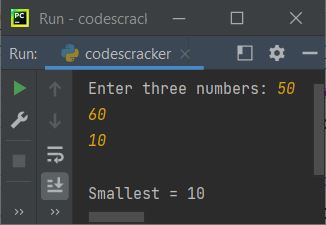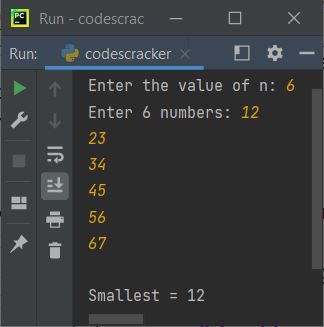- Python Built-in Functions
- Python All Built-in Functions
- Python print() Function
- Python input() Function
- Python int() Function
- Python float() Function
- Python len() Function
- Python range() Function
- Python str() Function
- Python ord() Function
- Python chr() Function
- Python ascii() Function
- Python pow() Function
- Python type() Function
- Python List Functions
- Python list() Function
- Python insert() Function
- Python append() Function
- Python extend() Function
- Python pop() Function
- Python remove() Function
- Python reverse() Function
- Python sort() Function
- Python sorted() Function
- Python Dictionary Functions
- Python dict() Function
- Python update() Function
- Python get() Function
- Python keys() Function
- Python setdefault() Function
- Python fromkeys() Function
- Python items() Function
- Python popitem() Function
- Python Tuple Function
- Python tuple() Function
- Python Set Functions
- Python set() Function
- Python frozenset() Function
- Python String Functions
- Python split() Function
- Python join() Function
- Python format() Function
- Python replace() Function
- Python Iterator Functions
- Python iter() Function
- Python min() Function
- Python max() Function
- Python sum() Function
- Python count() Function
- Python index() Function
- Python copy() Function
- Python clear() Function
- Python next() Function
- Python filter() Function
- Python enumerate() Function
- Python zip() Function
- Python reversed() Function
- Python Number Functions
- Python abs() Function
- Python bin() Function
- Python oct() Function
- Python hex() Function
- Python round() Function
- Python divmod() Function
- Python complex() Function
- Python File Handling Functions
- Python open() Function
- Python read() Function
- Python readable() Function
- Python readline() Function
- Python readlines() Function
- Python write() Function
- Python writable() Function
- Python writelines() Function
- Python close() Function
- Python seek() Function
- Python tell() Function
- Python flush() Function
- Python fileno() Function
- Python truncate() Function
- Python Class Functions
- Python object() Function
- Python property() Function
- Python getattr() Function
- Python setattr() Function
- Python hasattr() Function
- Python delattr() Function
- Python classmethod() Function
- Python staticmethod() Function
- Python issubclass() Function
- Python super() Function
- Python Misc Functions
- Python all() Function
- Python any() Function
- Python isatty() Function
- Python bool() Function
- Python callable() Function
- Python globals() Function
- Python locals() Function
- Python dir() Function
- Python id() Function
- Python isinstance() Function
- Python map() Function
- Python repr() Function
- Python slice() Function
- Python vars() Function
- Python Advance Functions
- Python help() Function
- Python hash() Function
- Python breakpoint() Function
- Python bytes() Function
- Python bytearray() Function
- Python memoryview() Function
- Python compile() Function
- Python eval() Function
- Python exec() Function
- Python Tutorial
- Python Tutorial
- Python Examples
- Python Examples
Python min() Function
The min() function in Python is used to find the smallest or minimum value among given set of values as its argument. This function can also be used to find the minimum item in an iterable. For example:
print(min(12, 43, 6, 45)) mylist = [32, 54, 34, 13, 54, 65] print(min(mylist))
The output produced by above Python program, demonstrating the min() function is given below:
6 13
That is, 6 is the smallest number among 12, 43, 6, and 45. Whereas 13 is the smallest element among 32, 54, 34, 13, 54, and 65.
Note: The min() function does the similar job to max(). The only difference is that the min() returns smallest, whereas the max() returns the largest. That's it.
Python min() Function Syntax
The syntax to use min() function in Python is:
min(arg1, arg2, arg3, ..., argN, key)
where arg1, arg2, and so on are values. The key parameter is used when we need to find the smallest string based on length, because the min() function, by default, returns the smallest string based on alphabetical order.
Note: Don't think much about the syntax, everything will get clear, using example programs given below.
Here is another syntax of min() function, when working with iterable.
min(iter1, iter2, iter3, ..., iterN, key, default)
Similar to previous syntax, iter1, iter2, and so on are iterable. The default parameter is used when we need to print the default minimum value, when the iterable is empty.
Python min() Function Example
Let's start with simple example of min() function:
print("Enter three numbers: ", end="") x = int(input()) y = int(input()) z = int(input()) print("\nSmallest =", min(x, y, z))
Sample run of this program, with user input 50, 60, 10 is shown in the snapshot given below:

Now let's create another program that does the similar job as of above program. The only difference is, this program uses list to find the smallest element in the list. Since the program uses list, therefore I've created the program in a way to allow user to define the size of list too, along with its elements:
print("Enter the value of n: ", end="") n = int(input()) print("Enter", n, "numbers: ", end="") mylist = [] for i in range(n): num = int(input()) mylist.append(num) print("\nSmallest =", min(mylist))
Here is its sample run with user input 6 as size of list, 12, 23, 34, 45, 56, 67 as its six elements:

Point to be Noted - If we pass strings as arguments of min() to find the minimum or smallest string, the function returns the smallest based on alphabetical order. For example:
minstr = min("William", "Matthew", "Noah", "Ethan") print(minstr)
Following is the output produced by this Python program:
Ethan
based on alphabets, Ethan is the smallest one. Now what if we need to find the smallest string based on the
number of character or length ?
Then we need to use the key parameter of min() function in that case.
Here is an example:
minstr = min("William", "Matthew", "Noah", "Ethan", key=len) print(minstr)
Now the output will be:
Noah
Here is another example demonstrates the min() function in Python:
x = [12.4, 54.6, 1.43] print(min(x)) print(min(12.32, 43, 54.65, 98.56, 32)) x = "codescracker" print(min(x)) x = {"Name": "Daniel", "Region": "Hawaii"} print(min(x))
Following is the output of this program:
1.43 12.32 a Name
Handle Exception Raised by min() Function in Python
If we provide values of multiple types, then the min() function raises an exception named TypeError. For example, the following program:
x = 23 y = "codescracker" print(min(x, y))
produces:

Now to handle this exception, we need to wrap the min() inside a try block, so that the exception raised by this function can easily be caught using the except block, as shown in the program given below:
x = 23 y = "codescracker" try: print(min(x, y)) except TypeError: print("Invalid combination of arguments!")
Now the output will be:
Invalid combination of arguments!
Of course the same program can also be created in this way:
x = 23 y = "codescracker" try: smallest = min(x, y) print(smallest) except TypeError: print("\nInvalid combination of arguments!")
The min() Function with Multiple Iterable
Here is an example of min() function with multiple iterable:
x = [10, 4, 5, 6, 3, 32] y = [32, 4, 6, 7] z = [43, 6, 54, 76, 7] print(min(x, y, z))
Following is the output produced by this Python program:
[10, 4, 5, 6, 3, 32]
Since the first list, that is x has the smallest element, that is 3, among all the elements from all the lists, therefore the output is the first list, that is x.
The min() Function with default Argument
This is the last program of this article, created to demonstrates, how the min() function with default argument is used:
mylist = [] print(min(mylist, default=0))
The output produced by this program will be 0. Because 0 is the default value that will be considered as the smallest one, in case if the iterable (list here) is empty. Basically the default parameter is used to avoid producing error, when the iterable is empty, or to consider the default value as the smallest, if the iterable is empty.
But if the iterable is empty, and the default parameter is not used, then the min() function produces an error. Let's take a look at the following program:
mytuple = () print(min(mytuple))
produces:

Therefore either use the default parameter to avoid this error. But the problem is, what if we do not want to
assign the default argument's value as the smallest, if the iterable is empty ?
Then in that case, you can put the
min() function inside a try block to get the exception raised using the except block, as shown in
the program given below:
mytuple = () try: print(min(mytuple)) except ValueError: print("The tuple is empty!")
now the output will be:
The tuple is empty!
« Previous Function Next Function »